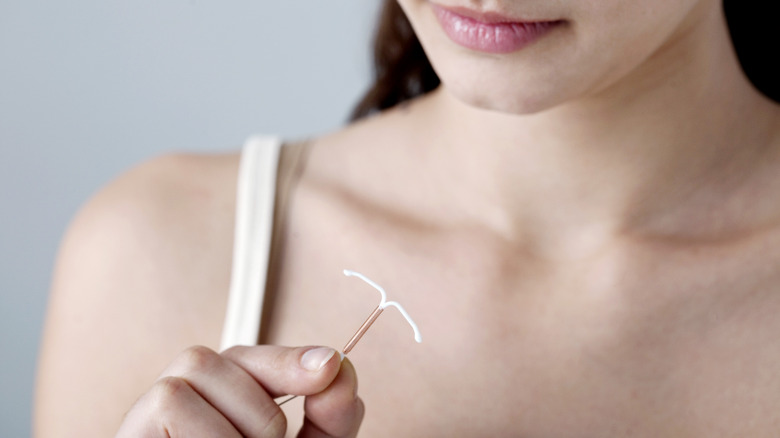The 2 IUD Myths You Should Stop Believing, According To A Public Health Expert
In a world with many birth control options, it can be confusing to choose the right one for your body, your circumstances, and your lifestyle. There are permanent methods of birth control like tubal ligation for women and vasectomies for men, and there are also less invasive options, including condoms and diaphragms. One form of birth control that has become incredibly popular because it is a low-maintenance and long-acting method is an IUD, or Intrauterine Device.
This tiny, T-shaped birth control option is inserted into a woman's uterus to prevent pregnancy. IUDs can last anywhere from three to 10 years, but they can be removed whenever a woman feels it necessary. The popularity of this approach to birth control can be attributed to its low-maintenance quality, but there are myths about this option women need to be aware of. According to public health expert, exposure scientist, and author of the popular website Evidence-Based Mommy Dr. Samantha Radford, there are many IUD misconceptions out there that need to be corrected, so women can be fully informed.
The pain free myth
When women consider the IUD plan of birth control, they are told about the many perks of this choice. These include the ease, the need to only have it implanted once, and the option to have it removed if they so wish. However, women are also told that the IUD is easy and painless. Dr. Radford explained to Glam that while some people experience no pain while having an IUD inserted, this is not true for everyone. The reason it could be painful is because the procedure is a bit invasive: "Your cervix has to be opened up to insert an IUD, and this can cause cramping, bleeding, and even nausea, dizziness, or fainting."
Dr. Radford warns that this pain can be significant enough that a woman may need to recover in an exam room for up to two hours after the insertion process. The IUD is a popular method of birth control, but this is a myth that can surprise women if they aren't made aware of the side effects of this invasive process.
The hormone myth
Another misconception that many believe about IUDs is that they release hormones into your uterus only, and this is simply not the whole story. While releasing hormones into your uterus is the goal, Dr. Radford reveals that this isn't the only place the hormones go. Some IUDs do cross into the bloodstream, and the side effects of this transfer of hormones can be overwhelmingly difficult for some women. "That means hormonal IUDs can cause hormonal side effects, such as mood swings, headaches or worsening depression," she says. Women need to be aware of these side effects so they can weigh the pros and cons of making this choice for birth control.
It is true that an IUD brings with it many conveniences for women considering birth control. They are both long-term and temporary depending on your preference, and are a low-maintenance way to prevent pregnancy. However, women should be informed about the side effects of making this choice for their bodies, so they aren't surprised when they arrive at their appointment. The best course of action is to meet with your gynecologist and discuss what's best for you.


